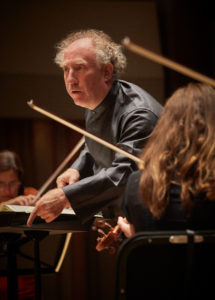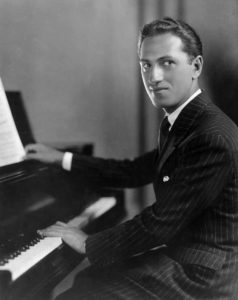We often think of classical and popular music as belonging to distinct, separate worlds, but for most of history this was not the case. In the Jazz Age especially, classical composers often made allusions to popular music; likewise, many popular songwriters would have a symphony stashed away to work on in their spare time. Perhaps the most famous example of a genre-bending piece of music is George Gershwin’s Rhapsody in Blue, the focal point of the Houston Symphony’s upcoming concerts with musical polymath Jeffrey Kahane.

Having made his name as one of the world’s foremost concert pianists, Jeffrey Kahane now finds himself equally in demand as a conductor, frequently performing both roles in his guest appearances with the great orchestras of the world. For his concerts in Houston, Jeffrey will perform the impressive feat of playing not one, but two virtuoso pieces for piano and orchestra: Gershwin’s legendary Rhapsody and Ravel’s Piano Concerto in G major. To round out the program, Jeffrey also conducts Milhaud’s jazzy ballet La création du monde (The Creation of the World) and a more recent work by American composer Timo Andres.
The French Connection
“All the pieces on the program are about the intersection between so-called ‘vernacular’ musical styles and the tradition of the concert hall,” Kahane explained. “It’s interesting to note, by the way, that Rhapsody in Blue is often cited as ‘the’ work that broke down the barriers between jazz and the symphonic tradition, but in fact the Milhaud ballet La création du monde was written earlier!”
French composers in particular were attracted to the new music coming out of the United States. “Both Ravel and Milhaud were deeply influenced by American jazz, and Milhaud was directly inspired by his experience in the early ‘20s of hearing jazz—which was then essentially a brand new art form—in clubs in Harlem,” Kahane said. Ravel’s Piano Concerto in G major, one of the composer’s last masterpieces, is famous for combining jazz with Ravel’s own sophisticated, French musical style. “I think the piece is one of the most sensuous of all piano concertos,” Jeffery noted, “and the opening page of the slow movement, which according to legend Ravel spent months perfecting, is one of the most moving things in all music. In fact, I think one could say that about the whole slow movement!”
Ravel famously met Gershwin during his tour of the United States in 1928, and Gershwin had also made a number of trips to Paris throughout the 1920s. “Gershwin, apparently, was a tremendous admirer of Ravel,” Kahane said. “There’s a famous (and probably apocryphal) story about Gershwin going to Paris and asking Ravel to teach him, to which Ravel responded by asking how much money Gershwin made each year. When Gershwin told him, Ravel allegedly said ‘Mr. Gershwin, I’d like you to teach me!’”
Rhapsody Like You’ve Never Heard It Before

Unlike Ravel, who was trained at the venerable Paris Conservatoire, Gershwin was largely a self-taught composer of popular music. After taking piano lessons as a kid, Gershwin dropped out of high school to become a song-plugger in New York City’s “Tin Pan Alley.” By age 20, he had become the toast of Broadway, but his ambitions extended into the concert hall as well.
Regarding Gershwin’s breakthrough concert piece, Rhapsody in Blue, Kahane noted that “It’s worth remembering that it was part of a Paul Whiteman concert that was entitled ‘An Experiment in Modern Music.’” The concert featured dozens of new pieces that were influenced by jazz, but the one that blew the audience away was Gershwin’s Rhapsody in Blue. “It is certainly a seminal work in the history of American music,” Kahane said. For his upcoming performance, Jeffrey has elected to perform the original jazz-band version of Rhapsody in Blue rather than the familiar full-orchestra version that was created by Ferde Grofé after Gershwin’s death. This will give audiences the rare opportunity to hear the piece as it would have sounded at its premiere in 1924. The original version is leaner, jazzier, and crackles with an electrifying authenticity.
Don’t Stop the Music
In the decades after World War II, an uncompromising modernist style became de rigueur for composers in the Western world, and few traces of jazz or other genres of popular music remained in the scores of post-war composers (the obvious exception, of course, was Leonard Bernstein). In more recent decades, however, the tide has turned back toward stylistic cross-pollination, as Jeffrey’s inclusion of a piece by the contemporary American composer Timo Andres demonstrates. “In my estimation, he is one of the most gifted and important young composers alive today,” Kahane said.
Andres’ Paraphrase on Themes of Brian Eno is an homage from one musician to another. Though he started out in the glam rock scene in the early ’70s, Eno is best known for his pioneering ambient music and work in films, video games and collaborations with bands such as U2 and Coldplay. “Brian Eno is a composer who has a foot both in the world of pop music and serious composition, and Timo has taken some of his popular tunes and made a kind of paraphrase in the 19th century sense of the word,” Kahane said. Liszt, for instance, was famous for creating virtuoso piano “paraphrases” of tunes from popular operas of his day. “It’s a tremendously charming and ingenious bit of work: a salute to an important figure of the last several decades that very much expresses Timo’s own voice as well.” — Eric Skelly & Calvin Dotsey
Ring in the New Year with Gershwin’s Rhapsody in Blue on January 4, 5 & 6! Get tickets and more information at houstonsymphony.org.



